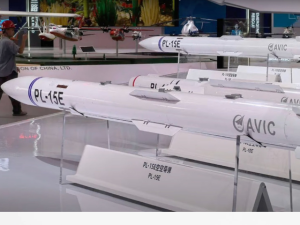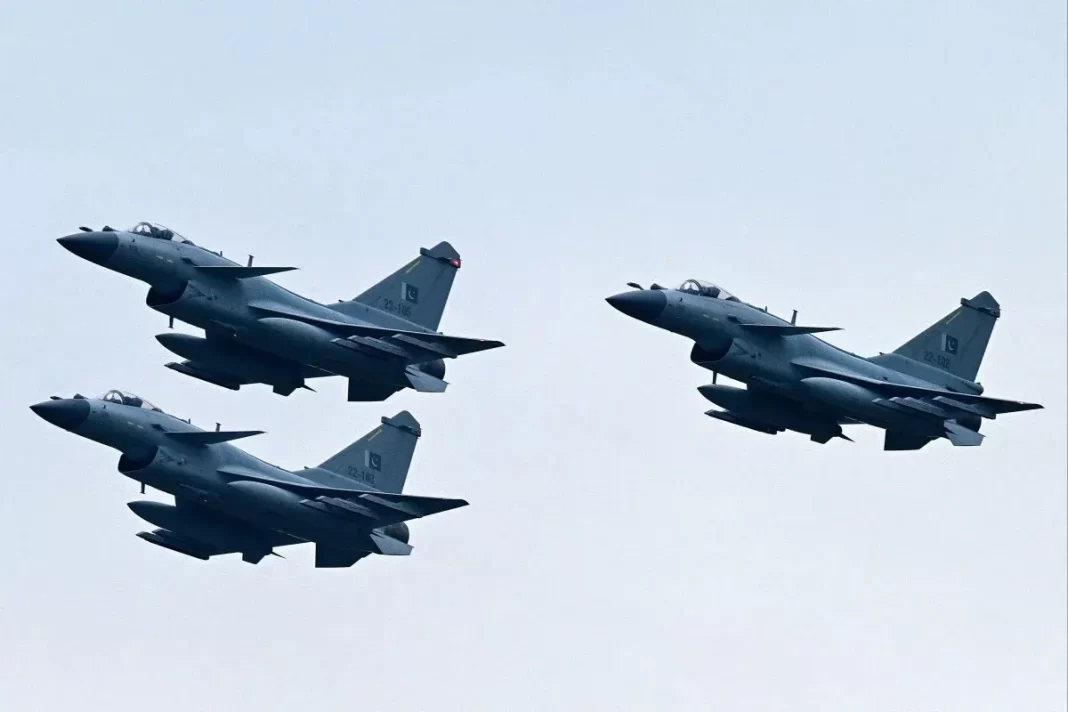Recent skirmish between Pakistan and India on one side, which had almost pushed both the nuclear dependent adversaries to the full-blown war territory is a change of magnitude to nature of war between them.
This marked the 1st time where the India operated French made 4.5 gen Rafale fighter jets shot down in battle.
Pakistan also did not resort to US arms, unlike in its previous conflicts; India on the other hand, has demoted Russian-made equipment after Western starts providing arms.
The fact is being viewed not only as a proxy test of China vs. Western military tech in real-life (which would potentially lead to heightened rivalry between arms races in the Global arms markets but can also provide influx diplomatic slam dust from Paris-Washington-NATO countries too).
And a few pundits have stressed the air force engagements, with some noting Chinese PL-15 air-to-air missiles may have been a tipping point in the possible role of these.
One of images uploaded on the social media displays a segment of the missile with a clear serial mark and seeker test port. In another, the missile’s seeker is much more likely, with an AESA radar providing excellent tracking and jamming resistance.
Air-to Air PL-15 missile
PL-15 ( a Chinese long-range, radar guided missile developed by Aviation Industry Corporation of China; AVIC) will be able to intercept airborne high-value targets out to ranges over 200km.
PL-15 is the standard active-radar guided AAM of People’s Republic of China and was expected to at least on-par with US made AIM-120D Advanced Medium-RangeAir-to-Air Missile (AMRAAM) conveniently coinciding with drawings released.

The export variant, PL-15E is said to have a range of up to 145 kilometres and is already married with Pakistan’s JF-17 Block III as well as those sold to Taiwan’s J-10CE fighters.
The range of domestically operated Chinese military (not sure what the ideal chinese equivalent is for this as I do not know any native speakers) is said to be somewhere between 300-500 kilometers.
South Asian theatre of combat
On April 26, the Pakistan Air Force (PAF) displayed JF-17s with PL-15E and PL-10 missiles as PL-15E on externally attached Sorouz missile carry. Pakistan: Pakistan used to have around 45-50 JF-17 Block IIIs and more erratically some seem believe they are in operation with about 20 J-10CEs totaling around 70 PL-15E fitting aircraft.
Guided by an inertial navigation system, upgraded Beidou satellites, two-way datalink and AESA radar terminal homing; The missile can reach speeds in excess of Mach 5 and its warhead is usually high-explosive fragmentation weighing between 20 to 25 kilograms.
Let it be with one hydrojet engine and can exceed Mach-5 It is a weapon which could have been otherwise procured straight from the People’s Liberation Army Air Force (PLAAF), of China but it was not independently confirmed.
And India air force; on them hand, are used Meteor missile equipped Rafales, Su-30MKIs with R-77 & S-400 SAMs. Range of PL-15 might require Pakistani fighters to take off from beyond India’s engagement envelopes
Pakistan finally acknowledged that its J-10Cs fighter jets, China-made from Chengdu, downed Indian Rafales but didn’t specify the type of munition employed.
But there are reports that Chinese PL-15 missile fragments have been found in the Hoshiarpur field in India’s Punjab state, which may mean this will be the first known active use of the missile.
It follows two US officials telling Reuters last month a Chinese-made fighter aircraft operated by Pakistan had shot down at least two Indian military jets for the first major operational milestone in Beijing’s advanced fighter systems.
And it made an announcement just two days after two US officials said a Chinese-Pakistani fighter was responsible for shooting down at least two Indian military planes.
At least one IAF Dassault Rafale aircraft was shot down during the skirmish between the Pakistan Air Force and a senior French intelligence official said the confirmed to CNN that one of their Rafales was brought down.
The discovery of the debris was another call to arms for air defense planning in the region and revealed to shifting South Asia arms dynamics at a time. Pakistan is slowly becoming dependent on Chinese systems unlike India which has been procuring diversified (and increasingly fragmented) from all sides.
Export-oriented and production ramping up by China State Media on PL-15E The fact that this system is located in a live conflict can give China some realworld operational data as well as presence on the global arms market.
No comment so far from China or Pakistan regarding the its manifestation.
A direct technological blow to Western systems – like the US AIM-120D AMRAAM and Meteor missile of France is the deployment of Chinese made PL-15 in South Asia. Although the Meteor is also the best in terms of no-escape zones & sustained ramjet propulsion, PL-15’s longer range and a further enhanced AESA guidance gives it a tactical edge in first-launch scenario — especialy fired from standoff ranges.
For the latest updates and insights on new developments, visit the NEWSON
Q1. What is the PL-15 missile?
The PL-15 is a long-range, active radar-guided air-to-air missile developed by China’s Aviation Industry Corporation (AVIC). It features an AESA radar seeker, a two-way datalink, and has an estimated range of over 200 km in its domestic version. The export variant, PL-15E, is used by Pakistan.
Q2. Was the PL-15 missile used in the recent India-Pakistan clash?
While not officially confirmed by China or Pakistan, multiple sources—including missile debris images and U.S. intelligence reports—suggest that the PL-15E was used by Pakistan Air Force aircraft to shoot down at least one Indian Rafale fighter jet.
Q3. How does the PL-15 compare to Western missiles like the AIM-120D and Meteor?
The PL-15 is designed to rival the U.S. AIM-120D and the European Meteor missile. While Meteor has superior no-escape zones and a ramjet propulsion system, the PL-15 is said to offer greater range and advanced tracking capability via its AESA radar.
Q4. Which Pakistani aircraft can carry the PL-15E missile?
The PL-15E is currently integrated with Pakistan’s JF-17 Block III and Chengdu J-10CE fighters. Reports suggest Pakistan operates up to 70 aircraft compatible with this missile system.
Q5. What impact does the PL-15 have on South Asia’s air power balance?
The inclusion of the PL-15E gives Pakistan a potential edge in beyond-visual-range (BVR) engagements. Its extended range could allow Pakistani fighters to engage targets while staying outside of India’s defensive radar envelope, thereby reshaping regional aerial strategies.
Q6. Has India responded to the PL-15 deployment?
India has not made an official statement regarding the PL-15’s usage but has relied on its Meteor-equipped Rafales, Su-30MKIs, and S-400 missile defense system to maintain aerial superiority. However, the performance of PL-15 in live combat could prompt a review of India’s current air-to-air missile inventory.


